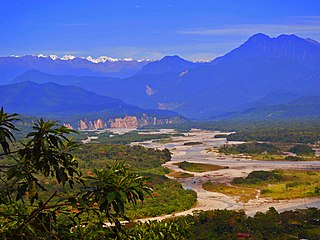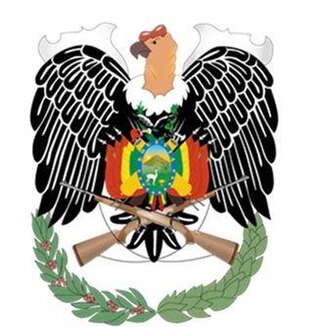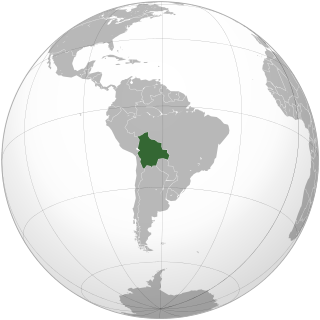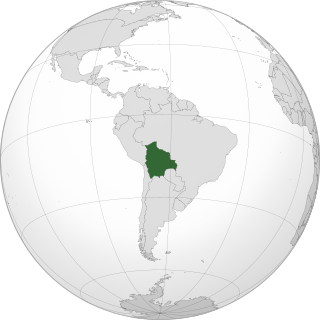| Total population | |
|---|---|
| 40,000 | |
| Regions with significant populations | |
| La Paz · Cochabamba · Pando · Santa Cruz | |
| Languages | |
| Brazilian Portuguese · Bolivian Spanish | |
| Religion | |
| Roman Catholicism | |
| Related ethnic groups | |
| Brazilian diaspora |
Brazilians in Bolivia consists of Bolivian people of Brazilian descent as well as immigrants and expatriates from Brazil. As of 2020, an estimated 40,000 Brazilians live in Bolivia. [1]
In the late 1980s, farmers from Brazil became attracted to Bolivia's undeveloped flat land, which has fertile soil, plentiful water and a tropical climate, which is perfect for crops such as soy, corn, sunflowers, rice and, wheat. [2] Many of them settled in the Bolivian department of Pando, which is just across the border from the Brazilian Amazon states of Acre and Rondônia. There are also Brazilian farmers in the Bolivian department of Santa Cruz who owned farmlands there as well.
Many Brazilian students have been coming to Bolivia to study medicine. [3] There are about 3,000 Brazilian students in the country, most of them enrolled in a medical course. The first Brazilian students arrived in Bolivia in the 1980s. They were attracted by the medical courses with low costs and without the requirement for college.
Thousands of Brazilians who live on Bolivian territory near the border with Brazil are suffering the threat of banishment because Bolivian President Evo Morales, under the claim of guaranteeing his country sovereignty, wants to settle 4,000 peasant families from La Paz and Cochabamba, onto 200,000 hectares located in the bordering region. [4]
In 2009, the Bolivian government had banished about 4,000 Brazilian rural workers, rubber tappers and farmers from the Pando department. The first people who have been expelled from the Pando department were poor Brazilian settlers' families. Some settlers have been forced to leave their homes and land, whereas others have been threatened to set fire to their possessions before handing them over to the Bolivians.
There is also discrimination against Brazilian students by the authorities and the population of Bolivia with claims of bias, demands for HIV tests and charging excessive fees and paperwork. [3] Representatives of the Bolivian government said the presence of young Brazilians significantly affected the culture of the cities where they stayed mainly Cochabamba and Santa Cruz de la Sierra. For many Bolivians, Brazilians promote more parties and have a bohemian behavior.

The geography of Bolivia includes the Eastern Andes Mountain Range which bisects Bolivia roughly from north to south. To the east of that mountain chain are lowland plains of the Amazon Basin, and to the west is the Altiplano which is a highland plateau where Lake Titicaca is located. Bolivia's geography has features similar to those of Peru which abuts Bolivia's northwest border; like Bolivia, Peru is bisected from north to south by the Eastern Andes Mountains, and these two countries share Lake Titicaca which is the highest navigable lake on Earth. Unlike Peru, however, Bolivia is one of the two landlocked countries in South America, the other being Paraguay, which is located along Bolivia's southeast border.

The Bolivian gas conflict was a social confrontation in Bolivia reaching its peak in 2003, centering on the exploitation of the country's vast natural gas reserves. The expression can be extended to refer to the general conflict in Bolivia over the exploitation of gas resources, thus including the 2005 protests and the election of Evo Morales as president. Before these protests, Bolivia had seen a series of similar earlier protests during the Cochabamba protests of 2000, which were against the privatization of the municipal water supply.

Beni, sometimes El Beni, is a northeastern department of Bolivia, in the lowlands region of the country. It is the second-largest department in the country, covering 213,564 square kilometers, and it was created by supreme decree on November 18, 1842, during the administration of General José Ballivián. Its capital is Trinidad.

Santa Cruz de la Sierra, commonly known as Santa Cruz, is the largest city in Bolivia and the capital of the Santa Cruz department.

Cochabamba, from Quechua qucha or qhucha, meaning "lake", pampa meaning "plain", is one of the nine departments of Bolivia. It is known to be the "granary" of the country because of its variety of agricultural products from its geographical position. It has an area of 55,631 km2. Its population in the 2024 census was 2,005,373. Its capital is the city of Cochabamba, known as the "City of Eternal Spring" and "The Garden City" because of its spring-like temperatures all year.

Pando is a department in Northern Bolivia, with an area of 63,827 square kilometres (24,644 sq mi), in the Amazon Rainforest, adjoining the border with Brazil and Perú. Pando has a population of 130,761. Its capital is the city of Cobija.

Law enforcement in Bolivia is reliant on the 40,000-member Cuerpo de Policía Nacional responsible for internal security and maintaining law and order. Unlike many South American countries, the Bolivian police force always has been accountable to the national government rather than to state or local officials. The 1950 Organic Law of Police and Carabiniers officially separated the police from the military. Frequently, however, the national police call upon the military for assistance in quelling riots and civil protests.

The Media Luna or Media Luna Ampliada refers to a group of four departments – Santa Cruz, Beni, Pando, and Tarija – in Bolivia which are home to a greater proportion of opponents to the national government led by Evo Morales and the Movement for Socialism (MAS) than the rest of the country. Pando has seen increasing support for MAS since 2009, while Tarija was initially supportive but has opposed MAS in every election after 2014. In contrast to the predominantly Indigenous Andean populations of the Andean region such as La Paz and Cochabamba, the departments in the Media Luna are majority mestizo, as well as being made up of the remaining 26 groups of lowland indigenes with white minorities, specifically in Santa Cruz de la Sierra.
The third tier of the Bolivian football league system consists of nine regional leagues ; the number of participants varies depending

The following outline is provided as an overview of and topical guide to Bolivia:

The 2008 Bolivian political crisis saw protests against President Evo Morales and calls for greater autonomy for the country's eastern departments. Demonstrators escalated the protests by seizing natural gas infrastructure and government buildings. In response, supporters of the national government and its reform of the constitution, mobilized across these regions.

The role of agriculture in the Bolivian economy in the late 1980s expanded as the collapse of the tin industry forced the country to diversify its productive and export base. Agricultural production as a share of GDP was approximately 23 percent in 1987, compared with 30 percent in 1960 and a low of just under 17 percent in 1979. The recession of the 1980s, along with unfavorable weather conditions, particularly droughts and floods, hampered output. Agriculture employed about 46 percent of the country's labor force in 1987. Most production, with the exception of coca, focused on the domestic market and self-sufficiency in food. However, with increased industrial agriculture starting in the early 2000s, exportation of commodities such as quinoa has grown substantially and local consumption has declined. Foreign industries' introduction of new machinery, monoculture, and chemicals to Bolivian agriculture has shifted production further away from Indigenous farmers and created a larger dependence on foreign markets. Agricultural exports accounted for only about 15 percent of total exports in the late 1980s, depending on weather conditions and commodity prices for agricultural goods, hydrocarbons, and minerals.
The old 2nd tier in the Bolivian Football pyramid consists of 9 regional leagues, the number of participants varies depending on the department, It usually has between 8 and 12 teams. Both winner and runner-up of each league compete in the Copa Simón Bolívar, with the winner of such tournament gaining promotion to the 1st Division, and the runner-up playing a play-off match with the 11th placed team in the 1st Division. Until 1976 all 8 regional championships were the top in the national football pyramid, with the winner of the Copa Simón Bolívar being crowned as national champion. In 2011, and for five seasons, the Copa Simón Bolívar was replaced by the Liga Nacional B, until 2016 when it was reinstated as Bolivia's second-tier football championship.
The Bolivian football league system is a series of interconnected leagues for association football clubs in Bolivia.
Narcotics in Bolivia, South America, is a subject that primarily involves the coca crop, used in the production of the drug, cocaine. Trafficking and corruption have been two of the most prominent negative side-effects of the illicit narcotics trade in Bolivia and the country's government has engaged in negotiations with the United States (US) as result of the industry's ramifications.

The 2010 Bolivia forest fires led the country's government to declare a state of emergency, as wildfires spread across the country. More than 25,000 fires are burning across 15,000 square kilometres. These raging fires have destroyed nearly sixty homes. Bolivia is unable to combat the fires properly as it does not have enough water bombing aircraft.

The history of the Jews in Bolivia goes back to the colonial period of Bolivia in the 16th century. In the 19th century, Jewish merchants came to Bolivia, most of them taking local women as wives and founding families that merged into the mainstream Catholic society. This was often the case in the eastern regions of Santa Cruz, Tarija, Beni and Pando, where these merchants came either from Brazil or Argentina.

The Indigenous peoples in Bolivia or Native Bolivians are Bolivians who have predominantly or total Amerindian ancestry. They constitute anywhere from 20 to 60% of Bolivia's population of 11,306,341, depending on different estimates, and depending notably on the choice Mestizo being available as an answer in a given census, in which case the majority of the population identify as mestizo, and they belong to 36 recognized ethnic groups. Aymara and Quechua are the largest groups. The geography of Bolivia includes the Andes, the Gran Chaco, the Yungas, the Chiquitania and the Amazon Rainforest.

Bolivian Spanish is the variety of Spanish spoken by the majority of the population in Bolivia, either as a mother tongue or as a second language. Within the Spanish of Bolivia there are different regional varieties. In the border areas, Bolivia shares dialectal features with the neighboring countries.

The 2021 Bolivian regional elections were held on 7 March 2021. Departmental and municipal authorities were elected by an electorate of approximately 7 million people. This was the third regional election under the 2009 constitution. It was postponed from the expected date of 2020 due to the 2019 Bolivian political crisis and delays in holding the 2020 Bolivian general election. All elected authorities assumed office on 3 May.